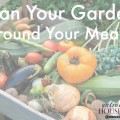In case of a survival situation, where you could no longer rely on a trip to the grocery store for food, it’s a good idea to prepare for a survival garden. If you and your family were facing a scenario where you had to grow food to maintain a well-rounded diet, your ability to plant, tend and harvest from a survival garden preparation would be a key factor.
The first thing you need to do is put together a survival seed bank. These are seeds that you would plant in the ground or in small containers until they are big enough to plant alone. A survival garden needs seeds for the fruit and vegetable plants that will most benefit you and your family. Therefore, one of the most important factors in choosing seeds for your survival garden is each food’s calorie totals. Instead of purchasing seeds for plants based on their taste, choose seeds that will contribute the most to your diet in an emergency situation.
Choosing Plants for a Survival Garden
Take a look at plants with moderate to high yields that feature low calorie crops:
- Turnips
- Cauliflower
- Peppers
- Mustard Greens
- Lettuce
- Cucumbers
Here are some plants with medium-calorie crops for a survival garden:
- Tomato
- Spinach
- Green beans
- Collard greens
- Cantalope
These hardy plants result in high calorie food:
- Navy beans
- Chick peas
- Kidney beans
- Lima beans
- Black-eyed peas
- Carrots
- Peas
- Sunflowers (for seeds)
- Peanuts
- Soybeans
Store all your seeds in a cool, dark and dry location, and they’ll last for several years. Rotate them with new seeds after about 3 years in storage. In your overall survival garden plan, don’t forget to store gardening tools, such as a rake, hoe, and shovel. Any other equipment you might need for survival gardening, such as gloves, should also be stored with the seeds.
Finally, include books, printouts and any other resources you might need to make a successful garden in your area. County extension offices should have growing schedules for when to plant certain seeds, how deep to plant them, how far apart seeds should be planted and when they are ready for harvesting. Depending on your area’s climate and rainfall, this information could mean the difference between a successful survival garden, or one that yields a disappointing harvest. For other food ideas, check out your local gardening club for brochures, growing guides and recommendations on the best varieties of seeds for your area.
Whether it’s a natural disaster that cuts off suppliers or a more serious survival situation, your survival garden seeds and plans can help you endure a situation where you must grow your own food.











Great post! I’m pinning it! I also linked up, thanks! 😀
Thanks!!
How funny…I am working, with some others, on a WWII exhibit for our County Fair and recognized this poster from some of the research we are doing. Amazing how small the world can seem when connections like this can be made.
Great post! I’ve been doing a lot of research on the topic myself as we created an infographic on what we think should be included in a survival garden. Would love your feedback on it.
http://theprepperproject.com/survival-food/